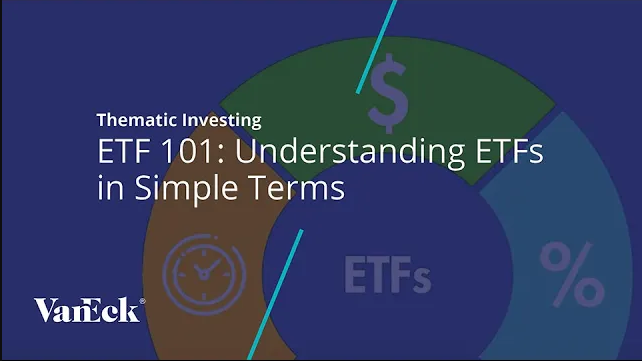ETF 101: Understanding the Basics
August 05, 2019
Read Time 3 MIN
ETF 101: Understanding the Basics
ETF 102: The Inner Workings of ETF Creations and Redemptions
ETF 103: Is This ETF Right for You?
ETF 104: Getting the Most Out of Your ETF Trades
ETF 105: Gaining Efficient Access to Bond Markets
ETF 106: Debunking Fixed Income Myths
ETF 107: Passive vs. Active ETFs Explained
Options for Investors
An ETF (Exchange Traded Fund) is a diversified collection of assets similar to a mutual fund, though a key difference is that an ETF trades on an exchange throughout the day like a stock. Being relatively low cost, tax efficient, and generally easy to buy and sell, ETFs have become a popular choice for many investors.
As of December 2018, there were more than 2,200 ETFs available in the U.S. market alone, accounting for more than $3.4 trillion in assets under management.1 Through ETFs, investors can gain access to a wide variety of asset classes and strategies—from stocks and bonds to commodities, domestic and foreign markets, individual sectors, alternative investments and sophisticated active strategies. Investors can use ETFs to support a range of their investment goals, whether ETFs form the core of a portfolio or are used to add diversification or manage potential risk.
Key Attributes of an ETF
Low Cost
ETFs are known for their relatively low cost and simple fee structures. Unlike mutual funds, there are no minimum investment amounts beyond the share price of the ETF. Buying and selling an ETF is akin to trading a stock. Therefore brokerage commissions and trading spreads are considerations when evaluating the total cost of an ETF.
Transparency
Underlying ETF holdings are generally disclosed in full on a daily basis, and share prices are updated in real time. Investors can gain up-to-date insight into their range of exposures, which can empower more informed asset allocation decisions.
Tax Efficient
Thanks to their structure, ETFs may be considered some of the most tax-efficient investment vehicles available to investors today. The underlying mechanics, such as the way ETF shares are created and redeemed, generally result in daily operations that generate relatively few taxable events. This, in turn, can translate into lower taxes for investors.
Tradability and Accessibility
Investors can quickly gain access to different asset classes, geographic regions, sectors, or strategies, from niche to broad. ETFs can offer exposure to investments that might otherwise be difficult to access, such as commodities or currencies. Investors are also able to trade ETFs intraday and employ trading strategies not possible with mutual funds, such as selling short or using limit orders.
ETFs and Mutual Funds Compared
Both ETFs and mutual funds have attractive investor benefits including portfolio diversification and professional management. They also have some key differences of which investors should be aware. Below is a summary comparison of key attributes of each structure.
| ETFs | Mutual Funds | |
| Pooled fund of securities offering diversification benefits | X | X |
| Professionally managed | X | X |
| Returns based on fund's underlying holdings | X | X |
| Intraday Trading | X | |
| Minimum Investment Size | X | |
| Sales Commissions (front-end or back-end loads) | X | |
| Trading Spread | X | |
| Brokerage Commission | X | |
| Transparency | Holdings disclosed daily | Holdings disclosed monthly, quarterly or semi-anually |
| Average net expense ratio1 | 0.56% | 1.12% |
Key Takeaways
ETFs are versatile tools for investors, suitable for a wide range of investment goals. Being able to trade ETFs on exchanges like stocks gives investors flexibility to employ different trading strategies and offers a relatively quick way for investors to add diversification to their portfolio. Features such as daily transparency of holdings, simple fee structures, and tax efficient operations make ETFs historically a cost-effective and straightforward investment vehicle.
ETF issuers are continually introducing new strategies, from traditional index-tracking funds to innovative funds constructed around investment themes. As with any investment, investors should carefully evaluate an ETF to determine whether it fits well within their portfolio.
Explore Our ETFs
Follow Us
IMPORTANT DISCLOSURES
1 Source: Morningstar. As of 12/31/2018
This is not an offer to buy or sell, or a solicitation of any offer to buy or sell any of the securities mentioned herein. The information presented does not involve the rendering of personalized investment, financial, legal, or tax advice. Certain statements contained herein may constitute projections, forecasts and other forward looking statements, which do not reflect actual results, are valid as of the date of this communication and subject to change without notice. Information provided by third party sources are believed to be reliable and have not been independently verified for accuracy or completeness and cannot be guaranteed. The information herein represents the opinion of the author(s), but not necessarily those of VanEck.
Past performance is not a guarantee of future results. Performance may be lower or higher than performance data quoted. Please visit vaneck.com for performance current to the most recent month end.
Diversification does not assure a profit nor protect against loss.
The "Net Asset Value" (NAV) of a VanEck Exchange Traded Fund (ETF) is determined at the close of each business day, and represents the dollar value of one share of the fund; it is calculated by taking the total assets of the fund, subtracting total liabilities, and dividing by the total number of shares outstanding. The NAV is not necessarily the same as the ETF's intraday trading value. VanEck ETF investors should not expect to buy or sell shares at NAV.
ETF Fund shares are not individually redeemable and will be issued and redeemed at their net asset value (NAV) only through certain authorized broker-dealers in large, specified blocks of shares called "creation units" and otherwise can be bought and sold only through exchange trading. Shares may trade at a premium or discount to their NAV in the secondary market. You will incur brokerage expenses when trading Fund shares in the secondary market.
Investing involves substantial risk and high volatility, including possible loss of principal. Bonds and bond funds will decrease in value as interest rates rise. An investor should consider the investment objective, risks, charges and expenses of the Fund carefully before investing. To obtain a prospectus and summary prospectus, which contains this and other information, call 800.826.2333 or visit vaneck.com. Please read the prospectus and summary prospectus carefully before investing.
Related Insights
March 23, 2020
September 27, 2019
Execute ETF trades as cost efficiently as possible by sticking to these important trading best practices.
September 13, 2019
September 03, 2019
The creation and redemption process is a fundamental feature of the ETF structure. Learn how this process works and its role in driving liquidity and tax efficiency for investors.
August 15, 2019
Related Funds
IMPORTANT DISCLOSURES
1 Source: Morningstar. As of 12/31/2018
This is not an offer to buy or sell, or a solicitation of any offer to buy or sell any of the securities mentioned herein. The information presented does not involve the rendering of personalized investment, financial, legal, or tax advice. Certain statements contained herein may constitute projections, forecasts and other forward looking statements, which do not reflect actual results, are valid as of the date of this communication and subject to change without notice. Information provided by third party sources are believed to be reliable and have not been independently verified for accuracy or completeness and cannot be guaranteed. The information herein represents the opinion of the author(s), but not necessarily those of VanEck.
Past performance is not a guarantee of future results. Performance may be lower or higher than performance data quoted. Please visit vaneck.com for performance current to the most recent month end.
Diversification does not assure a profit nor protect against loss.
The "Net Asset Value" (NAV) of a VanEck Exchange Traded Fund (ETF) is determined at the close of each business day, and represents the dollar value of one share of the fund; it is calculated by taking the total assets of the fund, subtracting total liabilities, and dividing by the total number of shares outstanding. The NAV is not necessarily the same as the ETF's intraday trading value. VanEck ETF investors should not expect to buy or sell shares at NAV.
ETF Fund shares are not individually redeemable and will be issued and redeemed at their net asset value (NAV) only through certain authorized broker-dealers in large, specified blocks of shares called "creation units" and otherwise can be bought and sold only through exchange trading. Shares may trade at a premium or discount to their NAV in the secondary market. You will incur brokerage expenses when trading Fund shares in the secondary market.
Investing involves substantial risk and high volatility, including possible loss of principal. Bonds and bond funds will decrease in value as interest rates rise. An investor should consider the investment objective, risks, charges and expenses of the Fund carefully before investing. To obtain a prospectus and summary prospectus, which contains this and other information, call 800.826.2333 or visit vaneck.com. Please read the prospectus and summary prospectus carefully before investing.
Related Insights
March 23, 2020
September 27, 2019
Execute ETF trades as cost efficiently as possible by sticking to these important trading best practices.
September 13, 2019
September 03, 2019
The creation and redemption process is a fundamental feature of the ETF structure. Learn how this process works and its role in driving liquidity and tax efficiency for investors.
August 15, 2019

